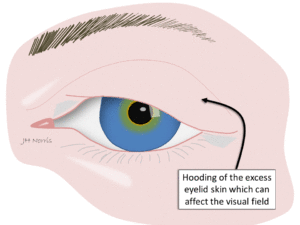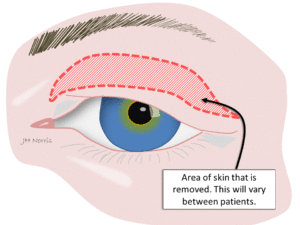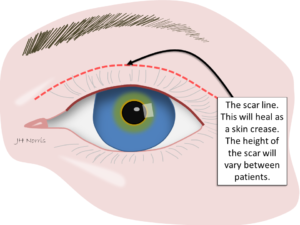The mainstay of treatment is surgery which is aimed at improving your vision or the sensation of the skin of the eyelids pressing on your eyelashes. Treatment is only available for this condition in certain circumstances and usually has to affect you vision before we can operate. We will often perform this surgery on both eyelids at the same time
We usually perform your surgery under local anaesthetic which is given in the operating room. Occasionally we can give sedation at the same time if you are uncomfortable about having a local anaesthetic on its own.
The surgery itself involves making an incision along the front of the upper eyelid and removing some of the excess skin and sometimes muscle.
We then suture the eyelid skin together and the scar forms your skin crease. This means that the scar forms your natural skin crease is therefore usually well hidden.
The surgery normally takes about 20 minutes per eyelid but can sometimes take longer.
During the surgery we will often ask you to look forwards to gauge the position of the eyelid after we have put the stitches in place.
The risks of surgery include postoperative bleeding, scarring to the eyelids and infection. We advise that you use an antiobiotic ointment after the surgery (see below) to help reduce the risk of infection.
Occasionally we may under or over correct the amount of skin that we remove and this can result in a different appearance between the eyelids. Sometimes the scar line can be slightly irregular with occasional small white cysts forming. Most of these complications can be corrected if needs be with a second operation.
The most serious risk of any eyelid surgery performed is damage to your eyesight. Fortunately this risk is extremely rare.
The eyelids will be bruised after surgery and you may have some bloodstained tears which is quite normal initially.
You should avoid any strenuous activity including lifting heavy objects for a least a week and avoid swimming for three weeks after surgery.
You should avoid any strenuous activity including lifting heavy objects for at least two weeks and avoid swimming for three weeks after surgery.
We will give you some antibiotic ointment (usually Chloramphenicol) to apply to the wounds and to the eyes after the surgery to help protect against infection and to help lubricate the eyes for two weeks
We advise that you apply ice compresses to the eyelids after surgery for three times a day for 5 minutes each time. This is to help reduce the bruising.
We normally see you after surgery to check the position of the eyelid.
Usually patients are quite anxious after having surgery near their eyes and most problems do settle with time. Problems that require immediate attention are the onset of new double vision, loss of vision and pain that cannot be controlled with regular painkillers. In particular if the eyelid swells up and you cannot open your eye then this requires an urgent review.
Please refer to the emergency contact page (under the header ‘Contact’) if you need advice.
Author: Mr Jonathan Norris FRCOphth



